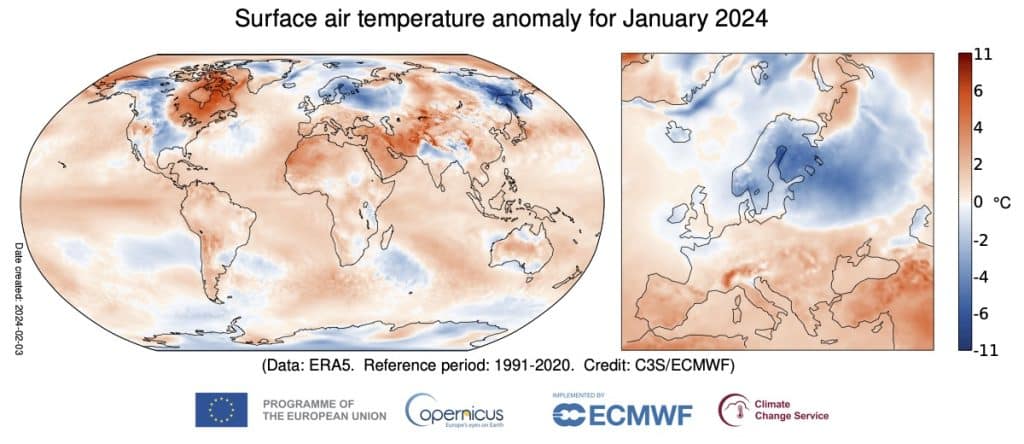This weekly round-up brings you key climate news from the past seven days, including the European Union’s new ambitious emissions reduction targets, devastating wildfires in Chile, and a new study assessing the flaws of the current hurricane risk assessment system.
—
1. Critical 1.5C Global Warming Threshold Breached Over 12-Month Period for First Time
The world’s average temperatures have been higher than the 1.5C global warming limit for 12 months in a row for the first time since records began, the European climate service Copernicus announced on Thursday.
The news came after last month was confirmed to be the hottest January in history, with average global temperatures 1.66C above pre-industrial levels, marking the eighth month in a row that average air temperatures have topped all prior records for the first time.

Between February 2023 and January 2024, global temperatures were 1.52C above the 19th century benchmark, higher than the critical threshold world leaders set in the 2015 Paris Agreement, the weather service said. While this does not signal a permanent breach of the limit, which scientists say is measured over decades, it sends a clear warning to humanity that we are approaching the point of no return much faster than expected.
Read more here.
2. European Commission Recommends Ambitious 90% Greenhouse Gas Emissions Reduction Target by 2040
The European Commission on Tuesday tabled a new pathway to reach climate neutrality by mid-century, recommending a greenhouse gas (GHG) emissions reduction target of 90% by 2040.
The draft includes a number of policies needed to achieve the ambitious target, including strengthening the bloc’s energy independence from fossil fuel imports, creating a level playing field for international partnerships, and implementing the existing binding legislation to cut emissions by at least 55% by 2030. Recent estimates show that member states are not yet on track to achieve the 2030 target, indicating that current energy and climate plans would only lead to a 51% cut in GHG emissions owing to delays in renewables deployment and energy savings.
Tuesday’s proposal will kick off what is expected to be a long debate on the targets, though it will be the new EU Commission and Parliament’s job to finalise and approve them after June’s European elections.
Read more here.
3. EU Leaders Call on ‘Full Ban’ of Forever Chemicals After Testing Positive for Cancerous Pollutants
A dozen European Union (EU) leaders, including former climate chief Frans Timmermans and current environment commissioner Virginijus Sinkevičious, have called for a Europe-wide ban on the use of toxic forever chemicals.
“They invade our environment, home-grown vegetables, fish, and our bodies, where they persist forever. We must stop all emissions of this legalized garbage – we call on Europe to fully ban the use of these chemicals,” said former EU climate chief Timmermans, who was among a group of eleven past and present EU officials who had their blood tested for 13 forever chemicals as part of an awareness campaign launched last year by the European Environmental Bureau (EEB) and Sweden-based International Chemical Secretariat (ChemSec). Up to seven toxic substances were found in all European politicians, with five of them exceeding safe levels.
A five-year programme which saw 13,000 people from 28 European countries being tested for the presence of 18 substances concluded last year that “the population is exposed to ‘alarmingly high’ levels of hazardous chemicals, especially of children,” despite Europe having one of the strongest chemical control systems in the world, with some of the seven PFAS tested already banned and others regulated.
Read more here.
4. Hurricane Scale Needs Category 6 to Reflect Climate Change-Driven Increase in Wind Speed, Scientists Say
The Saffir-Simpson hurricane wind scale, the most widely recognized risk assessment method for tropical cyclones, is no longer accurate in measuring the climate change-driven exponential increase in winds, a new paper argues.
Developed in 1971, the scale classifies hurricanes into five categories based on their sustained winds. To be classified as a hurricane, a storm must have a one-minute-average maximum sustained winds of at least 74 mph or 119 km/h (Category 1). Currently, the highest classification is assigned to storms with winds blowing at a speed of at least 157 mph or 252 km/h (Category 5).
However, a new paper published Monday in the Proceedings of the National Academy of Sciences (PNAS) argues that the Saffir-Simpson scale needs updating to reflect the exponential increase in wind intensity witnessed in recent years. According to Michael Wehner and James Kossin, who are behind a assessment, the fact that the scale is open-ended – meaning that anything beyond 157 mph or 252 km/h is classified as Category 5 and assigned the same level of wind hazard – reflects a flaw in the system, no matter if it is blowing 160 mph (257 km/h), like 2022 Hurricane Ian in the US, or 215 mph (346 km/h), like Mexico’s 2015 Hurricane Patricia.
Read more here.
5. Death Toll From Chile Wildfires Rises to 122 as Scientists Blame Long-Running Drought and El Niño
The death toll from the devastating wildfires in Chile has risen to at least 122, though authorities expect the number to climb further as residents, firefighters, and the military race against time to clear rubble in residential areas of the hard-hit coastal cities of Valparaiso and Vina Del Mar, west of the capital Santiago.
“We’re standing before a tragedy of immense proportions,” said President Gabriel Boric, who announced a two-day mourning period and said the wildfires were the worst disaster the country has seen since the 2010 earthquake and tsunami, which claimed more than 500 lives.
A decade-long drought in the country created the perfect conditions for the wildfires to break out and spread. This time, however, scientists say that on top of already existing arid conditions, last week’s blazes were also likely worsened by El Niño, a cyclical weather pattern that returned last year, bringing “off the charts” temperatures around the world and leading to significantly more intense extreme weather events. In October 2023, experts say the weather phenomenon is expected to last well into 2024.
Read more here.

















